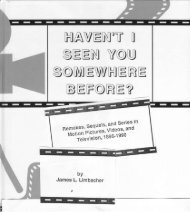DOWNLOAD Genocide in Our Time - NewFoundations
DOWNLOAD Genocide in Our Time - NewFoundations
DOWNLOAD Genocide in Our Time - NewFoundations
You also want an ePaper? Increase the reach of your titles
YUMPU automatically turns print PDFs into web optimized ePapers that Google loves.
i) A f<strong>in</strong>al form of cultural destruction that might be<strong>in</strong>cluded is ideological colonialism <strong>in</strong> which any culturalexpressions — us<strong>in</strong>g culture <strong>in</strong> both senses — whichpredate or oppose the particular state ideology arepurged. The most obvious of these have occurred <strong>in</strong>communist regimes, such as <strong>in</strong> Tibet, where theBuddhist religion, its build<strong>in</strong>gs, books, statues, monks,and nuns were systematically victimized and destroyedby the Ch<strong>in</strong>ese communists as expressions of anti-Ch<strong>in</strong>ese Tibetan nationalism, and where the traditionaleconomic organization was forcibly reorganized andredistributed. With<strong>in</strong> Ch<strong>in</strong>a itself, <strong>in</strong> Pek<strong>in</strong>g, precommunistbuild<strong>in</strong>gs, statues, and other "symbols ofOld Ch<strong>in</strong>a" were destroyed so that a new "symbol ofsocialist Ch<strong>in</strong>a" might be constructed." In Cambodiaalso, the era of the communist Khmer Rouge, 1975-1979, systematically destroyed all elements of modern,pre-communist 1 ifestyles, such as middle classes, healthpersonnel, urban dwellers, techniques and implementsof modern technology, and forms of social organizationbased upon the family group." In some of these casesit might be plausible to apply the term "autoethnocide"(ie. , ethnocide aga<strong>in</strong>st one's own people <strong>in</strong> a similarsense to how) "autogenocide" is used by the UnitedNations <strong>in</strong> reference to Cambodia.The "other side" of these ethnocidal measures isoften the establishment of special reserves or campsfor the displaced people. This is a widely practicedpolicy and may, under certa<strong>in</strong> conditions, act as aprelude to genocide (see below). The transference ofpeople to reserves can be both voluntary, as with thehill tribes of Thailand, where the state adm<strong>in</strong>istrationencourages Hmong settlement <strong>in</strong> the lowland campsbut does not force it"; or forcible, such as <strong>in</strong> Paraguay,where the Ache Indians are hunted and often killed andthe remnant rounded up and forced <strong>in</strong>to camps, whichare usually isolated and guarded. For the Ache thereis no hope of escape. Conditions are unsanitary andthere is very little medical aid or food; violerice, sexualabuse, starvation, and death are common place and theliv<strong>in</strong>g are reduced to states of abject despondency withlittle will or strength to survive."The Question of IntentThe crime of ethnocide has not been established<strong>in</strong> <strong>in</strong>ternational law <strong>in</strong> the same way that genocide wasestablished by the 1946 United Nations Convention.The question of the <strong>in</strong>tentions of those caus<strong>in</strong>g ethnociderema<strong>in</strong>s a crucial issue however, s<strong>in</strong>ce Article II(e)of the United Nations Convention —"Forcibly transferr<strong>in</strong>gchildren of the group to another group" — <strong>in</strong>cludesa specific form of ethnocide with<strong>in</strong> its area of jurisdiction.In at least this form, then, establish<strong>in</strong>g the<strong>in</strong>tentions beh<strong>in</strong>d the transfer of children can determ<strong>in</strong>ewhether or not the action can be punished by <strong>in</strong>ternationallaw. This may set a precedent for other formsof ethnocide to become embodied <strong>in</strong> <strong>in</strong>ternational lawas crim<strong>in</strong>al activities. The establishment of ethnocideas an <strong>in</strong>ternational crime is the second reason why"<strong>in</strong>tent" is important: the consolidation of a solid bodyof documentation which clearly demonstrates the<strong>in</strong>tentional destruction of dist<strong>in</strong>ct cultural groups willadd weight to this demand. At present ethnocidalactivities are roughly <strong>in</strong>cluded <strong>in</strong> a range of <strong>in</strong>ternationalcovenants such as the International Covenant onEconomic, Social and Cultural Rights (1976) but thesecan lack specificity and are not necessarily legallyb<strong>in</strong>d<strong>in</strong>g. ~While many cases of ethnocide have clearly been<strong>in</strong>tended to destroy the dist<strong>in</strong>ct cultural identity of aspecific group of people, others are less clear. Therapid expansion of state development projects might,at times, not <strong>in</strong>tend to br<strong>in</strong>g cultural destruction s<strong>in</strong>ceplann<strong>in</strong>g commonly alludes to vast tracts of emptywilderness. The use of this myth is not satisfactory,however; sufficient data clearly document the necessarysmall population-to-area ratio that is necessary for many<strong>in</strong>digenous cultures to survive <strong>in</strong> a fragile ecosystem.By resort<strong>in</strong>g to the "empty wilderness" myth, policydecisionmakers consciously override the existence ofthose <strong>in</strong>habit<strong>in</strong>g the land, and ignore the destructiveeffects of their policies; they also impose a particularset of laws on land ownership that are clearly notrecognized by the <strong>in</strong>digenous people, whose owntraditional laws are negated.Another example is the <strong>in</strong>tentions of many missionarieswhich <strong>in</strong> some cases have been not so muchdestructive as salvational, hop<strong>in</strong>g to raise "Satanworshipers"to a higher spiritual and civilized level ofhumanity. The establishment of reserves, supposedlyto protect the physical and cultural survival of a people,is another difficult area <strong>in</strong> which to gauge <strong>in</strong>tentions.The reality of the reserves can serve to expose theirdestructive consequences, as Richard Arens forcefullydemonstrated <strong>in</strong> his tour of four reservations at therequest of the Paraguayan state." Despite all of this,policymakers might cont<strong>in</strong>ue to declare that their<strong>in</strong>tentions were honorable.A further reason why the <strong>in</strong>tentions beh<strong>in</strong>d anypolicy are considered is that change is endemic to allsocieties. It is important to establish where change hasbeen generic, com<strong>in</strong>g from with<strong>in</strong> the society itself;where it has been forcibly imposed from outside of thecommunity; and where people have welcomed changebrought about by contact with outside cultures as ameans to rid themselves of outmoded or unwanted<strong>in</strong>ternal forms of organization — a form of chosenadaptation. Only the second type of change can beconsidered ethnocidal.4 GENOCIDE



